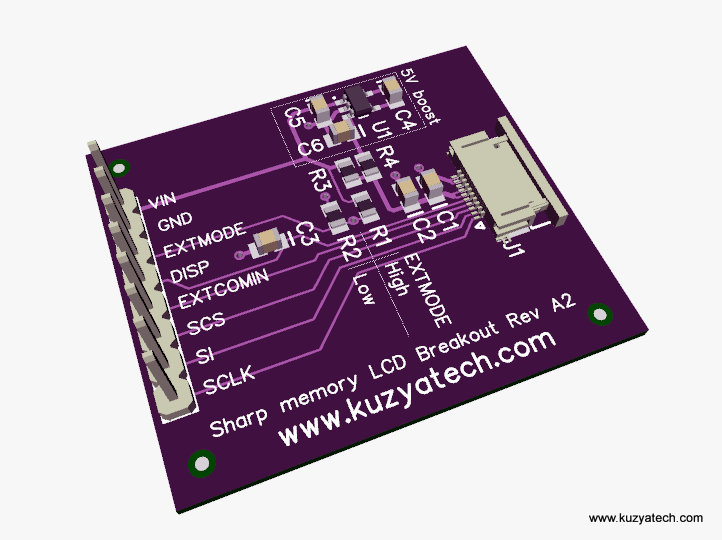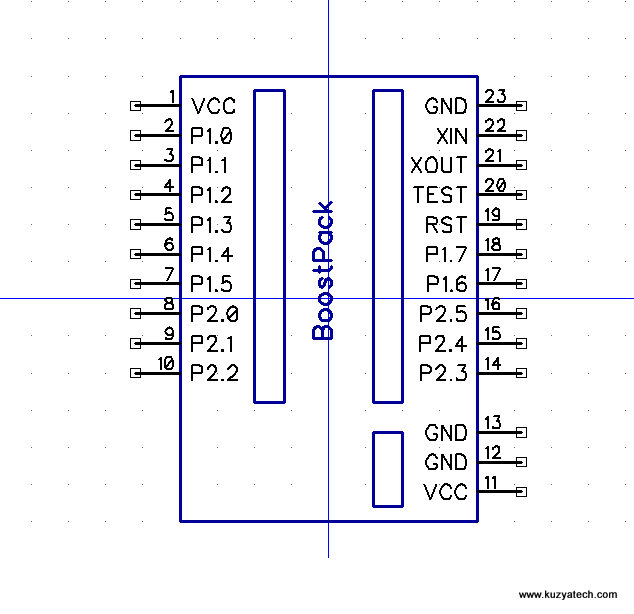I’ve been tweaking my Sharp LCD breakout board to make it suitable to more users. The latest iteration is off to the board house, but here is a quick preview:
Tag Archives: DipTrace
OSH Park rules for DipTrace
In response to a few requests, here is a design rules (DRC) file (OSHPark.zip) I created when ordering boards from OSH Park. To load them unzip the file and in Layout program, select Route- Load Rules. Note that the numbers are based on a somewhat limited information available. (For example I do not have data on the maximum hole size) The settings are as follows: Continue reading
TI Launchpad Booster Pack footprint library for DipTrace
Today’s post is a small DipTrace library i created for some TI Launchpad Booster Packs I am working on. It is modeled after a similar Eagle library posted on www.43oh.com forum.
There are two schematic symbols and three footprints:
Full size covers the whole Launchpad footprint
DipTrace layout and ordering boards from Dorkbot aka OSH Park
Well, my test design is complete and now I need a few prototypes to play with. The usual ways of ordering PCBs are rather expensive, with just tooling fees in hundreds of dollars. The remaining options are a few China based places such as Itead Studio, Seeed Studio ,PCB Pool and Batch PCB ran by Sparkfun, and an OSH Park ran by Laen from Dorkbot. He runs a community PCB service that groups orders and orders them periodically on a common panel, sharing costs between all people. The cost is very reasonable ($5 a square inch) and you get three boards. So a 2 square inches board in three copies will cost you $10 delivered from a US based board house! That definitely opens the door for quick prototyping of pretty much anything! After having used other company’s prototyping services, I must say OSH is also by far the most user friendly. Lets walk through the steps of ordering these boards. Continue reading
Blog update and some musings on EDA tools
Blog updates
Small blog updates this week. The sidebar is now present on all posts, not just the front page for easier navigation. The awesome picture of the Fluke board has now earned its spot as a blog header.I call it the “dancing transistors” banner. Sure beats stock image.
EDA tools choices
In more electronics related news, I’ve been working on a simple board using DipTrace. It’s a new tool for me, so a small simple design/layout and board order will test the waters so to speak. Why DipTrace you might ask, considering I already use high end packages at work such as Mentor Graphics Pads and Altium Designer, or how about Eagle? Well, for starters my hobby budget is small, and licensing Altium or Pads is well outside of it. I could potentially use Eagle, like everybody else does in the open hardware community, except for two things. Number one, I absolutely could not stand it when I tried it, and number two- the pricing structure is a bit silly. You either get a light version with 2 layers and a lot of limitations for $69, a Standard version for sch+layout for $575 or a professional for $1145. Sure, one could get a hobbyist/non profit version for $169 but first you have to sign a declaration that makes you liable the moment you design a board and sell a couple. Meh, not good enough. And at every level of pricing, there is still a board size limit. Enter DipTrace. The free/noncommercial license allows 500 pins and 2 layers. For a commercial version, Standard version with 1000 pins and 4 layers is only $345 and the full version with no limitations is $695. There is also an intermediate version that’s $495 and goes up to 6 layers. That to me seems like a much nicer upgrade path should I ever want to design and sell products. The fact that you could just pay the difference in price to go up the feature ladder is very smart as well.
Now back to work. Pictures/board info coming soon


